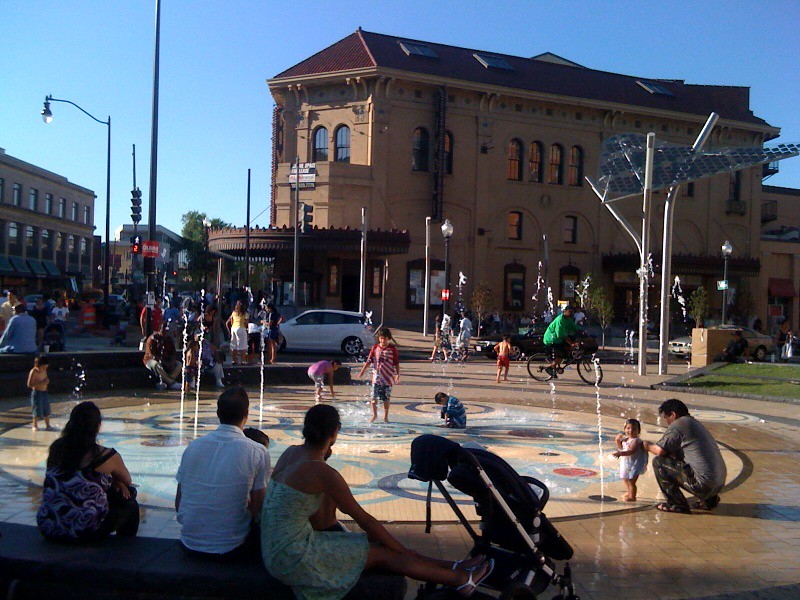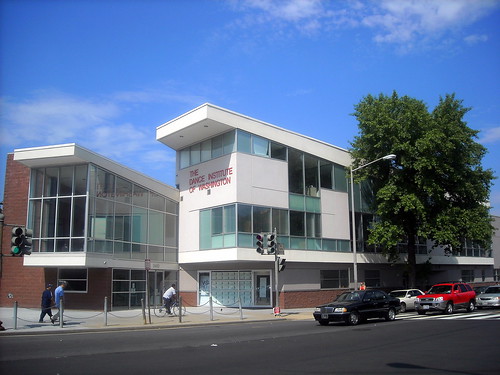
The water feature in the new plaza in Columbia Heights at 14th St NW and Park St only gets busier as the night goes on.
By some amazing serendipitous twist, I had the pleasure of staying last week with a writer who has worked in the community development, historic preservation, transportation, and public space arena. We got to talking about her neighborhood, Columbia Heights, which has gone through a lot of change in the last few years. A fascinating conversation, in that it underscored just how much context and firsthand experience of living through change informs our lens when deciding the type of change we want with our spaces.
Columbia Heights was recently rezoned, and instead of bundling the parcels for one developer, the local community development corporation decided to put each parcel out so that several developers would have a hand in the corridor. Having lived with the longstanding Atlantic Yards project in Brooklyn, this strategy didn't sound off any alarms for me. Different developers seemed to reduce the risk of a monolithic perspective dominating the area. Lisa had a another perspective: with so many developers weighing in on the neighborhood, cohesiveness was eroded and the opportunity to contextualize the new developments with the surrounding community was lost. No judgment here, the merits of this perspective are pretty clear.
The second differing opinion had to do with the design of the Dance Institute of Washington's new building. I had walked by it a few times and liked how it allowed pedestrians to see what was going on inside, a greater emphasis of opening up the studio to the neighborhood. 
The dance studios for the Dance Institute of Washington are transparent to the users of the street below.
This corner of a rehearsal studio in the redesigned building in Lincoln Center allows passersby to get a glimpse of the dance students.
My positive impression was perhaps largely informed by my habit during college of walking by the performing arts building on my way home after a long day. It was lovely to see the dancers working at the barre after spending hours studying in the stacks. As a mom, Lisa was concerned about the experience of the kids; me without kids, this perspective was simply not available to me.
In spite of our differing opinions, we had a great conversation about the neighborhood. Or perhaps, because of our differing opinions, we did. She helped me understand another way of looking. And it reminded me that we're constantly writing and re-writing the narratives for our neighborhoods.
7.25.2010
Perceptions of change: streets, buildings, neighborhoods
Posted by Shin-pei at 1:20 PM
Subscribe to:
Post Comments (Atom)
2 comments:
Love the splash park integrated into the urban fabric and the dance studio is fantastic. Thank you for sharing.
hey, that's me!
A couple of clarifications based on my now-distant recollections from circa 1998:
I think it'd be safe to say that our CDC definitely pushed for more development proposals and parceling over a single dominant developer--and it is widely known that the CDC has some (shall we say) vested interests in at least one of the developers who ultimately won contracts. Apart from that, though, it was really our city redevelopment agency (too lazy at the moment to google their proper name) that had final say on how the bidding went; a weird holdover from the fact that many of these parcels were the result of major fires during the 68 riots, and a lot of the land was actually owned or in receivership by the city--please someone, correct me if i have this completely or partially wrong.
The Dance Institute is a great place with a great mission. But they do train a lot of young kids, and this bldg is at a busy intersection, a lot of classes are at night, and I'm guessing a lot of the older kids go home on their own...so yeah, as a mom, I sort of think more thought could have been put into their privacy and security.
I could say more but I leave on a high note: that splash plaza and everything around it is a gift to the community!
Post a Comment